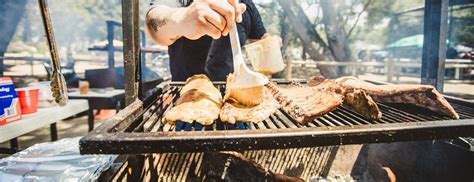The art of Santa Maria BBQ, a tradition deeply rooted in the culinary heritage of California’s Central Coast. This unique style of barbecue has been perfected over the years, emphasizing the use of high-quality meats, especially tri-tip, and a distinctive flavor profile that comes from the careful selection of woods for smoking, such as red oak. To guide you in mastering the techniques of Santa Maria BBQ, we’ve compiled a comprehensive set of tips, ensuring your next gathering features perfectly grilled, mouth-watering dishes that will leave your guests in awe.
Understanding the Basics of Santa Maria BBQ
Before diving into the advanced tips, it’s essential to grasp the fundamentals of Santa Maria BBQ. This style is characterized by its use of tri-tip, a cut of beef taken from the bottom sirloin, which is both flavorful and relatively affordable. The cooking process involves grilling over red oak wood, which impart a smoky, slightly sweet flavor to the meat. A key component is the use of a simple seasoning blend, often including garlic powder, salt, pepper, and sometimes paprika, allowing the natural flavor of the meat to shine through.
Mastering the Preparation
- Choosing the Right Meat: Opt for a high-quality tri-tip with a good balance of marbling for flavor and tenderness. Grass-fed or dry-aged options can offer unique and complex flavor profiles.
- Seasoning Ahead of Time: Season your tri-tip at least a day before cooking to allow the seasonings to penetrate deeper into the meat, enhancing the flavor.
- Wood Selection: Use red oak wood for smoking, as it’s traditional and provides a rich, smoky flavor. Always ensure the wood is dry to prevent smoke from becoming too acrid.
- Brining for Moisture: Consider brining your tri-tip, especially if it’s lean, to lock in moisture and add flavors. A simple brine of water, salt, and your choice of aromatics can make a significant difference.
Cooking Techniques
- Temperature Control: Maintain a consistent grill temperature. For tri-tip, aim for medium-high heat (around 400°F to 450°F) to achieve a nice crust on the outside while keeping the inside juicy.
- Direct and Indirect Heat: Use both direct and indirect heat zones on your grill. Sear the tri-tip over direct heat and finish it over indirect heat to prevent burning and promote even cooking.
- Wood Chips vs. Chunks: While red oak is traditional, feel free to experiment with wood chips or chunks to find the smoke level you prefer. Chips will smoke more intensely but for a shorter duration, whereas chunks provide a longer, slower smoke.
- Resting the Meat: After cooking, let your tri-tip rest for at least 10 to 15 minutes before slicing. This step is crucial as it allows the juices to redistribute, resulting in a more tender and flavorful final product.
Presentation and Serving
- Slicing Against the Grain: Always slice your tri-tip against the grain. This makes the meat more tender and easier to chew. Use a sharp knife to get clean, even slices.
- Traditional Sides: Serve your tri-tip with traditional Santa Maria BBQ sides such as pinquito beans, grilled or sautéed vegetables, and a fresh green salad for a well-rounded meal.
- Incorporating Local Flavors: Consider adding some local or seasonal elements to your meal to give it a personal touch. This could be anything from using locally sourced produce to incorporating regional spices and herbs into your seasoning blend.
Advanced Tips for the Enthusiast
- Experimenting with Marinades: While traditional Santa Maria BBQ leans towards simple dry rubs, don’t be afraid to experiment with marinades to add another layer of flavor. A mixture of olive oil, minced garlic, and your favorite herbs can elevate the dish.
- Smoking Other Meats: Don’t limit yourself to tri-tip. Santa Maria BBQ techniques can be applied to other meats like pork, lamb, or even vegetables for a vegetarian or vegan option, offering a smoked, savory flavor.
- Pairing with Wine and Beer: Santa Maria Valley is also known for its vineyards. Consider pairing your BBQ with local wines or craft beers to enhance the dining experience. A Cabernet Sauvignon or a Syrah can complement the bold flavors of the tri-tip, while a crisp beer can cleanse the palate between bites.
Conclusion
Mastering the art of Santa Maria BBQ is a journey that combines traditional techniques with personal innovation and experimentation. By understanding the core elements of this BBQ style, from the choice of meat and wood to the cooking techniques and presentation, you can host memorable gatherings that pay homage to the rich culinary history of California’s Central Coast. Remember, the key to perfecting Santa Maria BBQ is practice, patience, and a willingness to try new things while respecting the tradition.
Frequently Asked Questions
What is the most traditional type of wood used in Santa Maria BBQ?
+Red oak wood is the most traditional and preferred choice for Santa Maria BBQ, offering a rich, smoky flavor that complements the tri-tip perfectly.
How long should I let my tri-tip rest after cooking?
+It's recommended to let your tri-tip rest for at least 10 to 15 minutes after cooking. This resting period allows the juices to redistribute, making the meat more tender and flavorful.
Can I use other types of meat for Santa Maria BBQ?
+Yes, while tri-tip is traditional, you can experiment with other meats like pork, lamb, or even vegetables, applying the same smoking and grilling techniques to achieve a delicious and unique BBQ experience.
By embracing these tips and techniques, you’ll not only become proficient in the art of Santa Maria BBQ but also contribute to the preservation and evolution of this beloved culinary tradition. Whether you’re a seasoned BBQ enthusiast or just starting your journey, the world of Santa Maria BBQ welcomes you with its rich flavors, warm hospitality, and the promise of unforgettable meals shared with friends and family.



